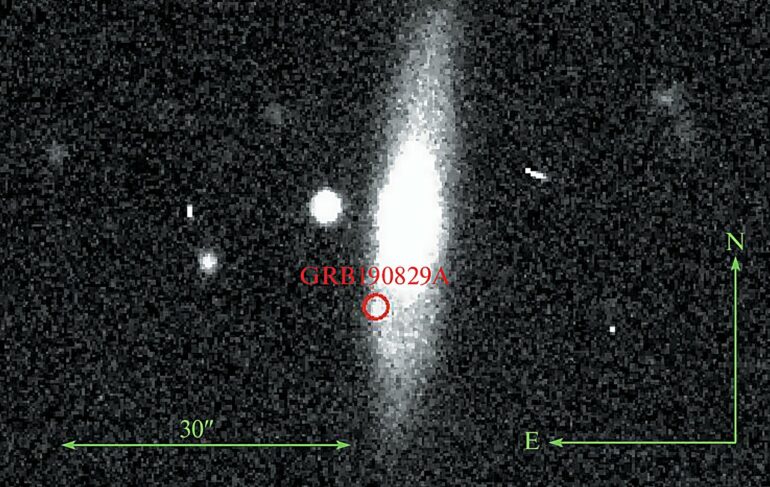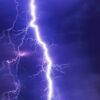The probability of detecting a supernova associated with a gamma-ray burst is currently 0.00346%. A network of several telescopes in different geographical coordinates, checking data in different photometric filters, analyzing images and taking into account the features of the host galaxy in which the burst occurred will help to discover more supernovae. The study was published in Pattern Recognition and Image Analysis.
A gamma-ray burst is the most powerful flare in the universe, emitting a huge amount of energy in the gamma range. The active phase of the burst may last less than a second, but it releases more energy than the sun in billions of years. The bursts were accidentally discovered in 1967, when a gamma-ray signal was registered by Vela, a secret American satellite launched to track nuclear explosions in the atmosphere from the USSR and Great Britain. But surprisingly, the signal came not from Earth, but from space.
Gamma-ray bursts usually occur at considerable distances from Earth and do not pose a direct threat. However, if such a burst occurs near our galaxy, the ozone layer that protects us from dangerous radiation will be damaged and all living things will be exposed to harmful cosmic radiation. Such a catastrophe would lead to the extinction of living organisms. Therefore, astrophysicists continue to study this phenomenon and its possible consequences in order to better understand and assess potential risks.
The exact mechanism of these bursts has not yet been fully studied, but, according to one theory, some appear after a supernova that occurs due to collapse.
Collapse is a phase in the evolution of a star with a mass 8–10 times larger than the sun, which activates when the star exhausts its supply of ‘nuclear fuel’ and ceases to resist gravitational compression. The density of its core becomes critically high and an explosion occurs—a supernova. During this explosion, a huge amount of matter is ejected into space at speeds of several hundred kilometers per second. This creates streams of particles that collide with the environment and cause gamma radiation.
Astronomical images of the GRB 201015A gamma-ray burst. The burst was detected on October 15, 2020. The left image shows the areas of its localization after 10 days, when the gamma-ray burst should fade out. In images from November, the source is seen to be dimming, which indicates that it is a supernova and the burst is caused by it.
At the same time, a supernova explosion is much less noticeable than the gamma-ray burst that it generates. Although astrophysicists have already detected about 13,000 gamma-ray bursts by 2023, only 45 have a proven connection with supernovae. In fact, the number of such bursts may be greater. HSE astrophysicists have analyzed the errors and selective effects that can occur when supernovae are detected and described how to minimize them.
The procedure for studying gamma-ray bursts is as follows: instruments of space observatories (Swift, Fermi, INTEGRAL) detect gamma radiation and transmit its coordinates to Earth. After that, researchers measure redshift, a parameter that characterizes the distance to the observation source. If the offset is less than or equal to 0.5, then there is a high probability that the gamma-ray burst was caused by a supernova and should be observed.
The supernova appears in the images 5–20 days after the gamma-ray burst. There are several limitations that can prevent it from being detected, for example, if the source is located too far from Earth.
“If we compare a gamma-ray burst to a lantern, then a supernova is like a candle. It ‘diffuses’ its energy in all directions, so it cannot shine as far as a gamma-ray burst that emits a beam in one direction. And if we find out that the redshift is relatively large and we can observe a gamma-ray burst, then in this case a supernova may remain unnoticed,” says Sergey Belkin, author of the article, doctoral student at the Joint Department of Space Physics with the Space Research Institute (RAS).
The researchers note that the host galaxy in which the supernova is located can also hinder its detection if it is too bright and eclipses the supernova or, conversely, so dusty that it absorbs and/or disperses its light.
“Metaphorically speaking, it’s the same as walking through the fog with a candle or a flashlight. If a person walks with a candle, it will be more difficult to see them, because the light will be absorbed and scattered, while a person with a flashlight is more likely to be noticed. Therefore, if a supernova is not visible in a particular filter in the host galaxy, it makes sense to observe the source in other photometric filters, in which the light absorption may be lower, and this will make it possible to isolate a supernova,” explains Sergey Belkin.
It’s also important to consider the place where the burst occurred. If it is observed in the arms, which are distant from the host galaxy’s center, then the chance of detecting a supernova will be higher than near its core.
The problem can be solved by observing the host galaxy for a few more days after the gamma-ray burst and the supernova have completely faded out, and then correlating the images of an already calm galaxy with the images obtained at the stage of an active supernova, and remove the galaxy background. The galaxy itself will disappear, and a supernova will be observed near its core.
On Earth, bad weather conditions can hinder research activity. In order for wind, humidity, rain, and cloud cover not to interfere with observations, the researchers propose organizing a unified network of observations in different geographical latitudes and longitudes.
“We need a well-established network of several telescopes located around the world. We hope that with the assistance of colleagues from different countries, this will be possible. We encourage researchers to carefully study every case that stands out from the general series, even if it initially seems insignificant,” comments Alexey Pozanenko, another author of the article.
More information:
S. O. Belkin et al, Systematics and Biases in Observations of Supernovae Associated with Gamma-Ray Bursts, Pattern Recognition and Image Analysis (2023). DOI: 10.1134/S1054661823020025
Provided by
National Research University Higher School of Economics
Citation:
Astrophysicists determine how to find a supernova (2023, October 6)



